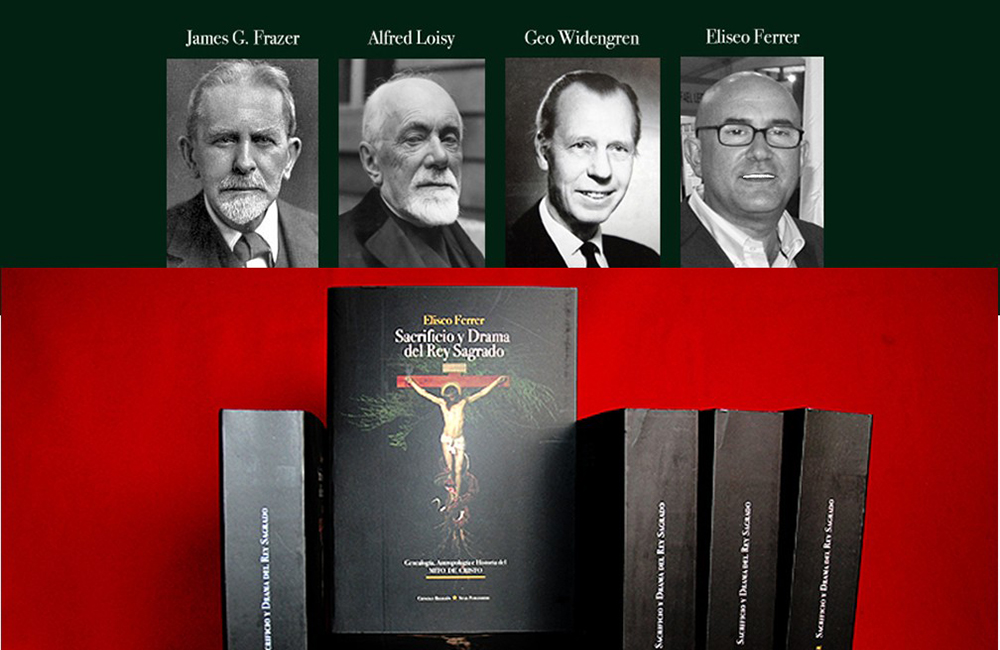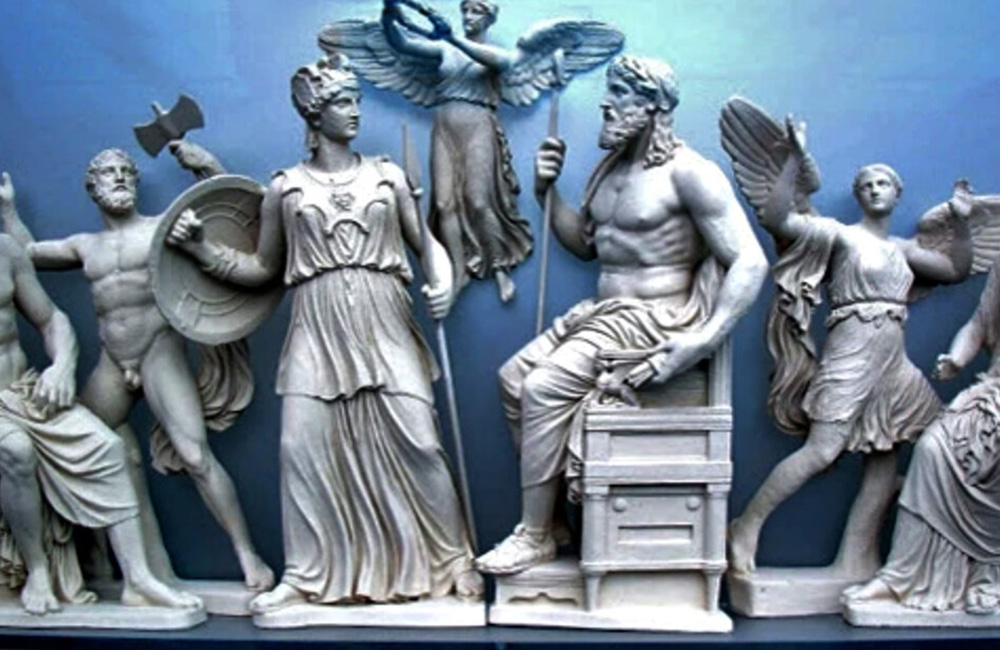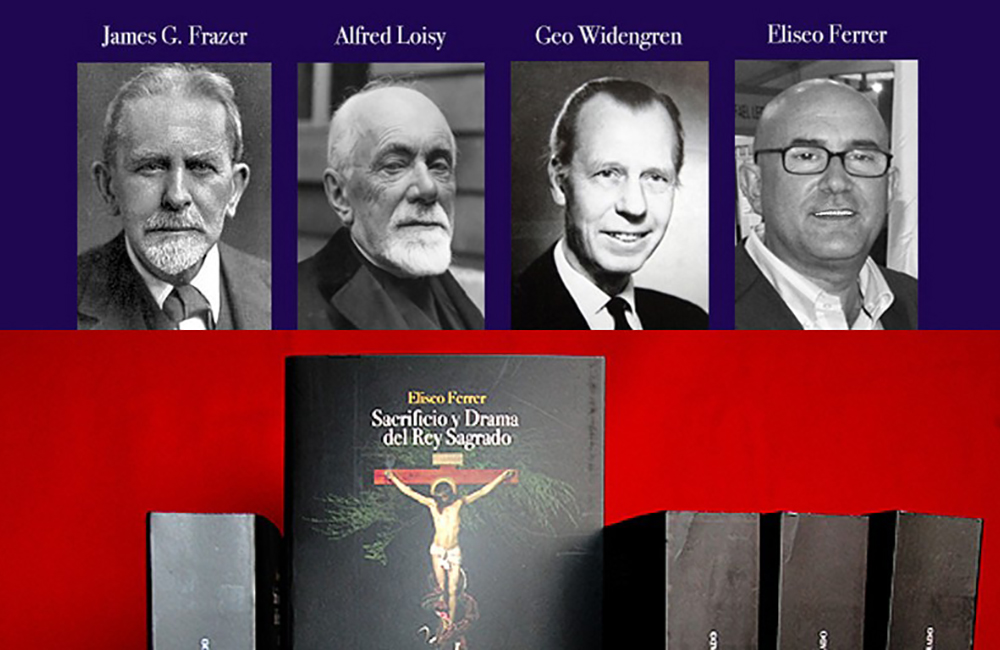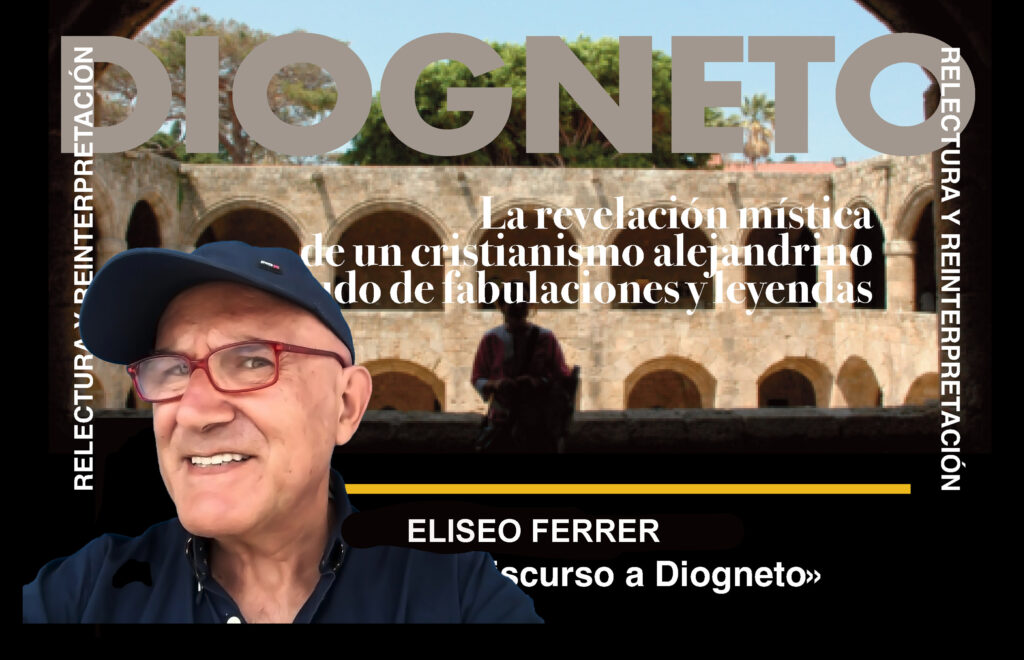Las culturas prehistóricas concibieron un cosmos interpretado a través del mito generador de «realidad», que hacía posible, con sus ritos, la renovación periódica del mundo.
© Eliseo Ferrer (Desde una antropología materialista).
Está claro que las primeras culturas agrícolas desarrollaron una visión cósmica del mundo, dentro de la cual el significado del mito, expresado en el ritual, se habría convertido en la base de las elucubraciones «espirituales» y «religiosas» posteriores. Se trataba del misterio central que explicaba la renovación periódica del mundo a través del poder oculto de la diosa como totalidad viviente y de su facultad visible manifestada por la muerte y la resurrección del hijo, hermano o amante de la divinidad. Un contexto en el que la Diosa Madre regulaba el flujo de los jugos de la tierra, que, por medio del árbol, extraía de las profundidades junto a las fuerzas fertilizadoras para conducirlas a la superficie y, de esta forma, nutrir el crecimiento de los frutos y asegurar la supervivencia de las bestias y los hombres. Al igual como se suponía que ocurría con la vida de estos últimos, como ya hemos visto, los ritmos cósmicos se expresaban en términos tomados de la naturaleza vegetal y de la agricultura, cuyos símbolos habían sido inspirados mucho tiempo atrás por las fases cambiantes de la luna. Todo lo cual terminó conformando una ideología dentro del ámbito de los primeros cultivadores en la que «el misterio de la sacralidad cósmica se representaba a través del árbol del mundo; pues el universo se concebía como un organismo [un árbol] que debía ser renovado periódicamente o, mejor dicho, regenerado todos los años».

Digamos que el árbol cósmico, como imagen fenoménica, moría en invierno y renacía en primavera, o permanecía permanentemente inalterable; si bien, como representación simbólica, encarnaba el paradigma de la muerte y la resurrección (y el de la inmortalidad) como ejes constitutivos del «aparente» movimiento del cosmos, que llevaba implícitos todos los demás fenómenos perceptibles. Pero hemos de tener en cuenta que los términos «imagen fenoménica» y «representación simbólica» son acuñaciones de nuestra cultura moderna y contemporánea, de gran utilidad operativa para entendernos en nuestro mundo, pero que nada tienen que ver con el contexto de las culturas de las primeras poblaciones sedentarias asentadas junto a los ríos y pantanos (Tigris y Éufrates, Nilo e Indo). Para la mentalidad y el pensamiento arcaicos, que comenzaba a descubrir las primeras dicotomías lógicas, la naturaleza y el símbolo, al igual que el sujeto y el objeto, eran una única y misma cosa que no podría disociarse.
A pesar de lo cual, no debemos caer en el error del considerar al árbol, por sí mismo, como un elemento de adoración, como el destinatario y el objeto de una ciega idolatría. La experiencia de las culturas primitivas concibió, como estamos viendo, un cosmos interpretado por el mito generador de «realidad» que hacía posible, con sus ritos, la renovación periódica del mundo. Y dentro de cuyo contexto el árbol cósmico se presentaba como uno de los principales signos y manifestaciones de la diosa, al tiempo que como inequívoca representación del drama experimentado por el hijo. Es decir, el árbol se hacía «sagrado» en virtud del poder oculto que le otorgaba el mito, al considerarle el paradigma visible del misterio de la muerte y la resurrección anual de la naturaleza, continuamente repetida; o dicho de otro modo: porque manifestaba la intuición de una «realidad» que estaba más allá y escapaba al «yo-tú» en el que se desenvolvía la cotidianeidad de la acción humana. «Por su simple presencia («el poder») y por su propia ley de evolución («la regeneración»), el árbol repetía lo que, para la experiencia arcaica, era el cosmos en su totalidad». Por eso, «un árbol se convertía en sagrado, sin dejar de ser árbol, en virtud del poder que manifestaba, y si se convertía en árbol cósmico era porque lo que manifestaba repetía punto por punto lo que sugería la totalidad del cosmos».
La presencia de una divinidad en un árbol o rodeada de vegetación fue un motivo recurrente en el arte plástico paleo-oriental, y puede observarse también en los restos de las culturas del valle del Indo, Mesopotamia, Egipto y Creta. Generalmente, y de manera invariable, el árbol representaba la presencia permanente y el poder de la diosa, así como su «encarnación» mundana o manifestación visible y evidente. De manera genérica, y desde un punto de vista meramente formal, podemos decir que los árboles daban a luz (parían) a los hijos de la diosa o dioses redentores, al tiempo que eran testigos de su propia muerte y posterior resurrección (Odín y el árbol Yggdrasil, por el que el dios cabalgaba uniendo la tierra, el cielo y el infierno; Osiris y el tamarisco, del que renacía en Biblos; Atis y el pino, bajo el que moría desangrado; Cristo y el árbol de la cruz o árbol del conocimiento, que permitía el acceso a la salvación proporcionada por árbol de la vida, etc. etc.). Por lo que se representó a estas deidades salvadoras como encarnaciones de la sabia vivificante y de las fases dinámicas y siempre renovadas de su desarrollo estacional. No en vano, las raíces del árbol sagrado se hundían en la tierra y el tronco crecía hacia la luz celeste, a la vez que registraba el paso del tiempo agregando un anillo a su estructura por cada ciclo anual de crecimiento.
Una de las primeras noticias de su indudable sacralidad nos la proporcionaba, dentro de la cultura sumeria y acadia, el Árbol de Eridu, plantado al parecer en el paseo de Ea de esa «opulenta» ciudad vecina al Éufrates. «En un largo sortilegio acádico de tipo médico se recogía una alusión a un mítico árbol de propiedades excepcionales, crecido en Eridu, y que ha sido considerado por algunos especialistas como el prototipo originario del Árbol de la Vida». Un modelo que se repitió sin duda en todas las culturas semíticas occidentales, hasta llegar a la Biblia hebrea, donde no sólo se hablaba de los dos famosos árboles situados en el Jardín del Edén, sino también del árbol ritual de Astarté que, según 2 Reyes, estuvo albergado en el interior la casa de Yahvé: «[Josías] asesinó a los sacerdotes idólatras que los reyes de Judá habían puesto para que quemasen incienso en los lugares altos […]. También sacó de la casa de Yahvé el árbol ritual de Astarté […]. Y destruyó las habitaciones de los varones consagrados a la prostitución ritual».
Y muy sobresaliente resultaba también, en este sentido, el detalle del encuentro de Osiris por Isis dentro del tronco del tamarisco; después de haber sido transportado por las aguas hasta Biblos, donde, al parecer, terminó fundiéndose con el árbol sagrado. O el del nacimiento de Adonis, amante de la diosa Afrodita, dentro de la corteza del árbol de la mirra. En cuanto a este último, contaba la leyenda que la bella princesa Mirra, su madre, había tenido amores con su padre, el rey de Chipre, y fue castigada por ello y convertida en árbol; y bajo esa forma dio a luz a su hijo Adonis, un joven tan hermoso que hasta la misma diosa del amor quedó impresionada ante su presencia.
Sobre la transformación de la princesa en el árbol de la mirra, que lloraba lágrimas de sabia, comentaba el poeta Ovidio:
La sangre se convierte en savia, los brazos en grandes ramas, los dedos en pequeñas hojas, y la piel se le endurece en calidad de corteza. Y ya el árbol que la va invadiendo le había apretado el grávido vientre y sepultado el pecho, y estaba a punto de taparle el cuello: no soportó ella la espera, y, saliendo al encuentro de la madera que se le acercaba, se hundió en ella y sumergió en la corteza el rostro.
Adonis fue una deidad mortal de la vegetación, cuya muerte y resurrección se celebraba, como símbolo de regeneración, todas las primaveras. Concepción de fondo que lo emparentaba, como vemos, con Osiris, incrustado su cuerpo dentro del tronco de un tamarisco, del que volvió a renacer de nuevo; un árbol que, dada su enormidad y magnificencia, terminó convirtiéndose en el pilar que serviría de fundamento al palacio de Malcandro. Digamos que Osiris, hermano y esposo de Isis, moría a manos de su hermano Seth (encarnación de la sequía y de la tierra roja), y comenzaba su renacimiento a través del árbol, cuando su sarcófago, a la deriva en el mar, tras ser transportado desde el río Nilo, llegada a las costas del Líbano y la vegetación crecía a su alrededor hasta cubrirlo y fundirlo dentro de su naturaleza. Y también Atis aparecía vinculado al espíritu de árbol, muerto y desangrado, en la versión más extendida, bajo un pino o un abeto, y cuya semana de pasión, en Roma, giraba en torno al tronco que, transportado desde los bosques cercanos, servía de patíbulo al dios hijo-amante de la diosa Cibeles. Al sumerio Dumuzi, amante de la diosa Inanna, se le llamó también «señor del árbol de la vida». Y no hemos de olvidar que, aunque caracterizado por la vid y el racimo de uvas, una de las advocaciones de Dioniso era asimismo la de «dios de los árboles». Pues no en vano en Beocia era conocido como «Dioniso en el árbol», y su imagen representada frecuentemente por un leño erguido en forma de poste y cubierto por un manto. Igualmente, la reina Maya se apoyaba en el tronco de un árbol mientras daba a luz al Buda, quien, convertido en adulto, alcanzaría la iluminación bajo el árbol boddhi. Por su parte, el dios Odín (Wotan o Woden) de la mitología nórdica era colgado del árbol sagrado en beneficio de la salvación de los hombres. Y Mitra, el dios asociado al sol, nacía, según la leyenda, en una cueva, aunque en algunas variantes narrativas la deidad de origen persa emergía de una roca o de un árbol como Sol Invictus durante el solsticio de invierno. «Un título [sol invencible] que recayó naturalmente en Jesús, quien nacía al mismo tiempo. La vida de Jesús aparecía también repleta de árboles imaginarios. Su padre terrenal era un carpintero, artesano del árbol caído. Y en el Rigveda, el arquitecto del universo, Tvastri, era imaginado como un carpintero que fabricaba el mundo, haciéndolo existir».
Por encima de cualquier consideración, el árbol reproducía ante todo el drama cósmico de la muerte y la resurrección del hijo, amante o esposo de la diosa, por cuanto desaparecía y volvía nuevamente a la vida en primavera, augurando el mismo porvenir al resto de los mortales. Digamos que el proceso obedecía al principio de morir para volver a vivir de nuevo, mientras el árbol de hoja perenne terminaría simbolizando la inmortalidad y la vida eterna en una etapa mucho más avanzada de la cultura y la civilización. Si bien, el árbol no era solo la imagen del cosmos que representaba el drama protagonizado por el hijo; era también el eje del mundo o axis mundi: un símbolo ubicuo presente en casi todas las culturas, cuya idea expresaba el punto de conexión y la continuidad entre el cielo, la superficie de la tierra y el inframundo habitado por los muertos. Hemos de reconocer que ésta fue una idea generalizada en las distintas culturas de los primeros cultivadores, que proyectó su ideología y sus valores a todo el mundo antiguo. Claro ejemplo de ello fue el hecho de que Hesíodo situara el Tártaro (el lugar subterráneo donde recibían castigo los dioses que desobedecían los mandatos de Zeus), en lo más profundo del Hades, incluso «por debajo de las raíces de la tierra».
De manera muy general, podemos decir que el «Árbol» estaba ubicado imaginariamente en el centro del mundo, en el omphalos griego, y se presentaba como el pilar central y sostén que sujetaba el universo: la columna Djed de los egipcios que se erguía como símbolo de renovación propiciado por la inundación de las aguas del Nilo. Se solía representar a través de su imagen universal y arquetípica, hundiendo sus raíces en la tierra y proyectando sus ramas verdes hacía el cielo; pero en ocasiones, como en el caso de la India antigua, aparecía como un árbol invertido, representando la creación en un sentido descendente. En este caso, sus semillas y raíces espirituales se encontraban en el cielo, y su tronco y sus ramas se proyectaban sobre el mundo, de la misma forma que los rayos del sol se desparraman sobre la superficie de la tierra.
Como vemos, el árbol cósmico, de carácter ubicuo, adquiría diferentes variantes y manifestaciones; y quizá por ello los eruditos e investigadores le han ofrecido múltiples denominaciones, que, en ocasiones, y a pensar de una voluntad clarificadora, no hacen sino oscurecer su verdadero significado. Pero, en el fondo, nos encontramos con una misma realidad que tan solo presenta formas y matices diferentes. Por eso, obligados a clarificar sus significados, en este trabajo optamos por la perspectiva diacrónica que nos presenta el árbol cósmico de carácter primitivo, por una parte, y las dos variantes bíblicas, por otra, más evolucionadas, del árbol de la vida (inmortalidad) y el árbol del conocimiento (sabiduría). Se trató, sin duda, de tres niveles de significación que se alternaron y fusionaron frecuentemente bajo la denominación genérica y universal de «árbol sagrado», cuyas más agudas y perfiladas manifestaciones las encontramos en Escandinavia, Mesopotamia, Egipto y la India antigua.
En este sentido, uno de los casos que con más claridad ejemplificó el eje del mundo fue el del fresno Yggdrasil, que crecía en los bosques sagrados de las mitologías germánica y escandinava: el axis mundi que atravesaba y comunicaba los tres ámbitos de la realidad cósmica: el inframundo o infierno, la tierra y el cielo. «El árbol Yggdrasil, situado en el centro, simbolizaba y al mismo tiempo constituía el universo. Su cima tocaba al cielo y sus ramas abarcaban el mundo. Una de sus raíces se hundía en el país de los muertos (Hel), la otra llegaba al país de los gigantes y la tercera al mundo de los hombres. Desde que brotó, es decir, desde que el mundo fue ordenado por los dioses, Yggdrasil estuvo amenazado de ruina, pues un águila comenzó a devorar su follaje, su tronco empezó a pudrirse y la serpiente Niddhog se puso a roerle las raíces. Un día no muy lejano Yggdrasil caerá, y entonces sobrevendrá el fin del mundo (ragnarók)».
En la mitología escandinava Yggdrasil presentaba una amplia simbología: era el poderoso fresno de hoja caduca en el que Odín se sacrificó por el bien de los hombres; se le consideraba también fuente de vida e inmortalidad, a cuya sombra se reunían los dioses en concilio para deliberar. Y como árbol cósmico, además, servía de unión entre los tres mundos, pues sus ramas se elevaban hasta el Walhalla, y de sus raíces fluía un manantial de agua pura, origen de los ríos y símbolo del transcurso del tiempo terrenal. Por otra parte, la presencia y la lucha del águila y la serpiente que devoraban sus hojas y raíces fue interpretada siempre como un símbolo cosmológico de la dualidad y de la lucha entre la luz y las tinieblas; de oposición de los dos principios, el solar y el subterráneo, que aparecía en todas las mitologías y muy especialmente en el hinduismo, donde se nos presentaba la lucha del pájaro mítico Garuda, enemigo de las serpientes, contra todo tipo de reptiles.
De la misma manera, la tradición de la antigua India, desde sus primitivos textos, representaba al cosmos bajo la forma de un árbol gigante recreado de manera invertida (Aśvattha, o higuera sagrada). «En las Upanishads se precisaba dialécticamente esta concepción: el universo era un “árbol invertido” que hundía sus raíces en el cielo y extendía sus ramas sobre la tierra entera». En la Katha Upanishad se describía como el árbol eterno cuyas raíces estaban arriba y cuyas ramas aparecían abajo, representando la pureza inmaculada: «Era el brahman, lo que se llama la no muerte. Todos los mundos descansaban en él». Por su parte, en la Bhagavadgītā, el árbol cósmico invertido llegaba a expresar no solo el universo, sino también la condición del hombre en el mundo: «Se decía que hay un Aśvattha imperecedero, con las raíces arriba y las ramas abajo, cuyas hojas son los himnos del Veda; pues quien lo conoce, conoce el Veda».
En el antiguo Egipto, Hathor, la diosa egipcia del amor, se representaba también, como otras deidades, con figura arborescente. Pero el árbol sagrado era allí el sicómoro, quien aparecía a menudo con las ramas cargadas de regalos, al tiempo que el agua fluía a su alrededor. De acuerdo al Libro de los Muertos, había dos sicomoros gemelos en la entrada de la puerta este del cielo, desde donde Ra emergía cada día. «Identificado por los egipcios como Nehet, el sicomoro era una higuera de la especie Ficus Sycomorus de madera incorruptible, pero de calidad tosca, por lo que no hay que divagar demasiado para entender cuáles fueron las razones para relacionarlo con los conceptos de nacimiento, regeneración o infinitud». Aparecen documentados varios cultos consagrados al sicomoro, de entre los cuales el más destacado fue el de la diosa Hathor como “Señora del Sicómoro del Sur” en Menfis, donde se consideró a este árbol como «El Cuerpo Viviente de Hathor en la Tierra», de cuyo centro asomaba para ofrecer alimentos y agua; y nutría bajo su forma a los difuntos.
En opinión de algunos autores, el sicomoro tuvo también relación con Osiris hasta comienzos de la época romana. Pero en el antiguo Egipto el sauce fue también símbolo de esta divinidad, posiblemente porque en una de las versiones de su leyenda (la otra habla del tamarisco) fue el árbol que protegió su cuerpo cuando, después de ser asesinado, quedó varado en la costa de Biblos. «Otra narración comentaba que sobre sus ramas se posaba un ave, que era el “alma” de Osiris, bajo la forma de pájaro Bennu, cuyo cuerpo se encontraba bajo éste. Por todo ello, todos los centros religiosos en los que se veneraba el culto al dios del inframundo se jactaban de poseer la hipotética tumba de Osiris y se adornaban con este árbol, símbolo del dios. En Egipto existía, además, una fiesta anual denominada la “erección del sauce” y en el templo de Hathor de Heliópolis existía una capilla llamada “capilla para alzar el sauce”. El simbolismo de ambas guardaba sin duda estrecha relación con el campo, el crecimiento de los árboles y con la ceremonia de la erección del pilar o la columna Djed».
La primera referencia que tenemos de Osiris aparece datada en el año 3000 antes de nuestra era, coincidiendo con la primera dinastía egipcia, dentro de la cual el faraón se denominaba a sí mismo como «el hijo de Isis». Y ya en los Textos de las Pirámides y más tarde en El Libro de los Muertos se hablaba del árbol de la vida. No hemos de olvidar que Osiris fue el arquetipo egipcio del dios muerto y resucitado, y quizá la deidad neolítica más antigua documentada en el marco de la historia antigua junto al sumerio Dumuzi, amante de la diosa Inanna. Al parecer, y como luego veremos, la representación del drama de la muerte y la resurrección de Osiris se celebraba en Abidos en el mes de Khoiak (noviembre) a lo largo de ocho días. En el momento más importante de la celebración, el día de la resurrección, «se elevaba un tronco de árbol descomunal al resonante grito de “Osiris ha resucitado”. Esta columna, conocida como Djed, sostenía las cuatro ramas cruzadas que representaban los cuatro cuartos del universo (demarcados por la cruz solar) y las cuatro fases de la luna. Y tras ser erguida se convertía en el árbol de la vida, pues para los antiguos egipcios Osiris era el símbolo más eminente de la resurrección». En los Textos de las Pirámides leemos que «las golondrinas ofrecían al difundo el árbol de la vida, del cual los dioses vivían, para que el difunto viviese junto a ellos». Y en El Libro de los Muertos, se representaba a los difuntos vestidos de lino blanco y con sus necesidades de subsistencia satisfechas; pues éstos aparecían sentados en la campiña de Osiris, cerca de un lago, y comían del árbol de la vida, cuyos frutos, según el Apocalipsis, deberían alimentar muchos siglos después a los habitantes de la Jerusalén celestial, con sus moradores también ataviados con vestiduras blancas. Se trata de testimonios antiquísimos quizá solo sobrepasados en edad por determinados poemas sumerio-acadios en los que, entre los muchos nombres adjudicados al consorte, hijo o amante de la Diosa Madre, se encontraba el del «señor del árbol de la verdad». Uno de estos poemas expresaba el sentido de la relación hijo-amante con su madre-esposa y hablaba de un gran árbol cuyas raíces se extendían hasta las profundidades de la tierra.
_____________________________________________
© Eliseo Ferrer









